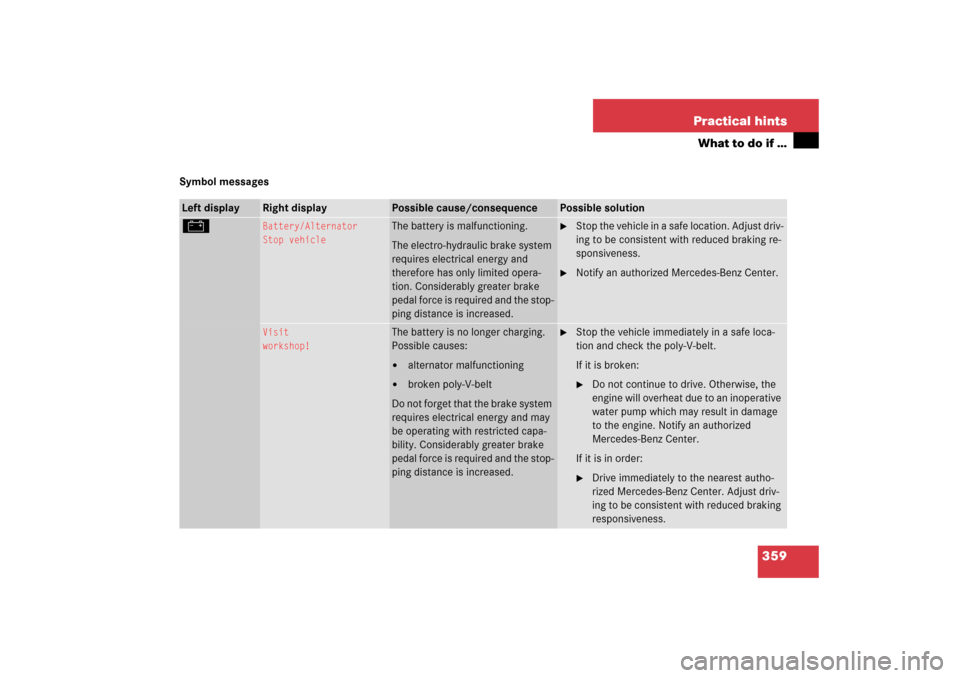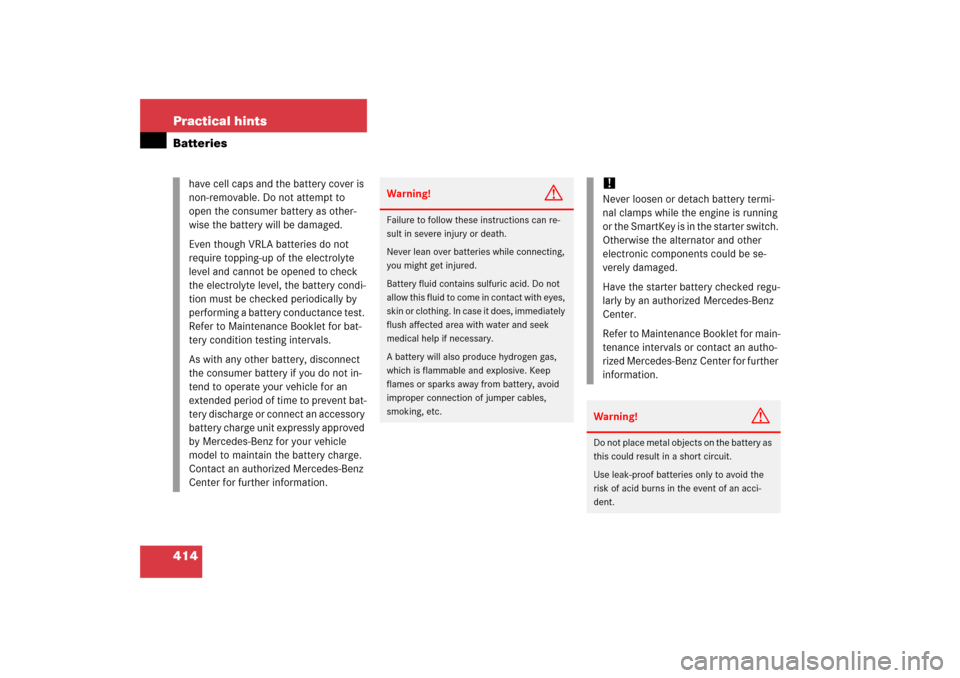Page 360 of 480

359 Practical hints
What to do if …
Symbol messagesLeft display
Right display
Possible cause/consequence
Possible solution
#
Battery/Alternator
Stop vehicle
The battery is malfunctioning.
The electro-hydraulic brake system
requires electrical energy and
therefore has only limited opera-
tion. Considerably greater brake
pedal force is required and the stop-
ping distance is increased.
�
Stop the vehicle in a safe location. Adjust driv-
ing to be consistent with reduced braking re-
sponsiveness.
�
Notify an authorized Mercedes-Benz Center.
Visit
workshop!
The battery is no longer charging.
Possible causes:�
alternator malfunctioning
�
broken poly-V-belt
Do not forget that the brake system
requires electrical energy and may
be operating with restricted capa-
bility. Considerably greater brake
pedal force is required and the stop-
ping distance is increased.
�
Stop the vehicle immediately in a safe loca-
tion and check the poly-V-belt.
If it is broken:�
Do not continue to drive. Otherwise, the
engine will overheat due to an inoperative
water pump which may result in damage
to the engine. Notify an authorized
Mercedes-Benz Center.
If it is in order:
�
Drive immediately to the nearest autho-
rized Mercedes-Benz Center. Adjust driv-
ing to be consistent with reduced braking
responsiveness.
Page 415 of 480

414 Practical hintsBatteries
have cell caps and the battery cover is
non-removable. Do not attempt to
open the consumer battery as other-
wise the battery will be damaged.
Even though VRLA batteries do not
require topping-up of the electrolyte
level and cannot be opened to check
the electrolyte level, the battery condi-
tion must be checked periodically by
performing a battery conductance test.
Refer to Maintenance Booklet for bat-
tery condition testing intervals.
As with any other battery, disconnect
the consumer battery if you do not in-
tend to operate your vehicle for an
extended period of time to prevent bat-
tery discharge or connect an accessory
battery charge unit expressly approved
by Mercedes-Benz for your vehicle
model to maintain the battery charge.
Contact an authorized Mercedes-Benz
Center for further information.
Warning!
G
Failure to follow these instructions can re-
sult in severe injury or death.
Never lean over batteries while connecting,
you might get injured.
Battery fluid contains sulfuric acid. Do not
allow this fluid to come in contact with eyes,
skin or clothing. In case it does, immediately
flush affected area with water and seek
medical help if necessary.
A battery will also produce hydrogen gas,
which is flammable and explosive. Keep
flames or sparks away from battery, avoid
improper connection of jumper cables,
smoking, etc.
!Never loosen or detach battery termi-
nal clamps while the engine is running
or the SmartKey is in the starter switch.
Otherwise the alternator and other
electronic components could be se-
verely damaged.
Have the starter battery checked regu-
larly by an authorized Mercedes-Benz
Center.
Refer to Maintenance Booklet for main-
tenance intervals or contact an autho-
rized Mercedes-Benz Center for further
information.Warning!
G
Do not place metal objects on the battery as
this could result in a short circuit.
Use leak-proof batteries only to avoid the
risk of acid burns in the event of an acci-
dent.
Page 432 of 480
431 Technical data
Layout of poly-V-belt drive
�Layout of poly-V-belt drive
SL 500
1Automatic belt tensioner
2ABC tandem pump (pump for
power-steering assistance and ABC
chassis)
3Air conditioning compressor
4Crankshaft
5Coolant pump
6Generator (alternator)
7Idler pulley
SL 55 AMGThe SL 55 AMG has two poly-V-belts (belt
one shown in purple/belt two shown in
black).1Idler pulley
2Automatic belt tensioner
3ABC tandem pump (pump for
power-steering assistance and ABC
chassis)
4Air conditioning compressor
5Crankshaft
6Coolant pump
7Generator (alternator)
8Idler pulley
9Automatic belt tensioner
aSupercharger
SL 600, SL 65 AMG
1Automatic belt tensioner
2ABC tandem pump (pump for
power-steering assistance and ABC
chassis)
3Air conditioning compressor
4Crankshaft
5Coolant pump
6Generator (alternator)
7Idler pulley
8Idler pulley
9Idler pulley
Page 443 of 480
442 Technical dataElectrical systemModel
SL 500
SL 600
SL 55 AMG
SL 65 AMG
Generator (alternator)
14 V/150 A
14 V/180 A
14 V/180 A
14 V/180 A
Starter motor
12 V/1.7 kW
12 V/1.7 kW
12 V/1.7 kW
12 V/1.7 kW
BatteryStarter battery
12 V/35 Ah
12 V/35 Ah
12 V/35 Ah
12 V/35 Ah
Battery for electrical consumers
12 V/70 Ah
12 V/70 Ah
12 V/70 Ah
12 V/70 Ah
Spark plugs
Bosch F 8 DPP 33
NGK PFR5R11
NGK IFR6QG
NGK ILFR6A
NGK IFR6QG
Electrode gap
0.039 in (1.0 mm)
0.028 in (0.7 mm)
0.031 in (0.8 mm)
0.028 in (0.7 mm)
Tightening torque
15 – 22 lb-ft
(20 – 30 Nm)
18 – 22 lb-ft
(25 – 30 Nm)
18 – 22 lb-ft
(25 – 30 Nm)
18 – 22 lb-ft
(25 – 30 Nm)
Page 458 of 480

457 Technical terms
Overspeed range
Engine speeds within the red marking
on the tachometer dial, see “Tachome-
ter” (
�page 133). Avoid this engine
speed range, as it may result in serious
engine damage that is not covered by
the Mercedes-Benz Limited Warranty.
Parktronic (Parking assist)*
System which uses visual and acoustic
signals to assist the driver during park-
ing maneuvers.
Poly-V-belt drive
Drives engine-components (alternator,
AC compressor, etc.) from the engine.Power train
Collective term designating all compo-
nents used to generate and transmit
motive power to the drive axles, includ-
ing
�
engine
�
clutch/torque converter
�
transmission
�
transfer case
�
drive shaft
�
differential
�
axle shafts/axles
Production options weight
(
�page 311)Program mode selector switch
Used to switch the automatic transmis-
sion between standard operation (S)
and comfort operation (C).
SL 55 AMG with steering wheel gear-
shift control and manual shift program:
In addition to S and C (for regular S or
comfort C operation, see above), you
can use MANUAL for manual shift pro-
gram.
PSI
(P
ounds p
er s
quare i
nch)
(
�page 312)
Recommended tire inflation pressure
(�page 312)
REST
(Residual Engine Heat Utilization)
Feature that uses the engine heat
stored in the coolant to heat the vehi-
cle interior for a short time after the en-
gine has been turned off.